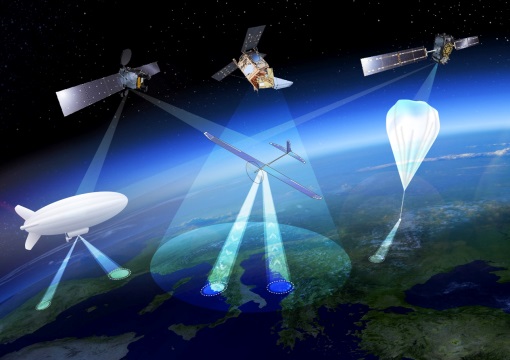Since the 1990s, a number of initiatives have been launched worldwide to explore the potential applications of High Altitude Pseudo Satellites, also called High Altitude Platform Stations (HAPS). HAPS are aircraft positioned above 20 km altitude, in the stratosphere, for very-long-duration flights counted in months and even years. These unmanned aircraft may be airplanes, airships or balloons. A number of HAPS development projects have recently reached more advanced development stages, which indicates that first operational services could be expected by 2018 - 2022.
The use of HAPS is considered for a variety of applications, such as telecommunications, emergency/public safety communications, intelligent transportation systems, maritime surveillance, environmental monitoring, land border control applications, etc. HAPS could offer advantages and complementary applications over satellites, terrestrial infrastructures and Remotely Piloted Aircraft Systems (RPAS), at relatively low cost. In this context, space assets could play a key role in the development of these new services.
The objectives of this feasibility study is to identify and analyse technically and economically sustainable applications and services relying on HAPS complemented by communication, navigation and/or remote sensing satellites. The study will eventually propose a roadmap for service(s) implementation and demonstration.
The study will be supported by the European Maritime Safety Agency (EMSA), EU SatCen and Frontex who can provide requirements and guidance to the team. EMSA is specifically interested in assessing the potential of the utilisation of HAPS for maritime safety, while Frontex focusses on land-border control and pre-frontier intelligence.
The bidding organisations will be required to propose specific services with clear business cases, sustainability potential, a clear added value of space assets, and involving representative users / customers.
Feasibility studies will be eligible for:
- 100% funding
- up to €200K
- up to nine months of study duration
HAPS4ESA Workshop
On 9 and 10 October 2017, ESA is organising a workshop entitled "Towards an ESA Stratospheric High Altitude Pseudo-Satellites (HAPS) programme for Earth Observation, Telecommunications and Navigation" (http://www.haps4esa.org/), to gather all interested parties from industry, science, academia, regulatory bodies, policy makers, as well as users to present and discuss synergies between satellites and HAPS, and to collect feedback and recommendations regarding a potential future ESA HAPS programme.
WEBINAR Recording
This video is a recording of the webinar which was held on 15 September 2017. It is designed to guide you through the scope of work and bidding process for this Feasibility Study. The recording includes the Q&A session at the end of the webinar.
WEBINAR Presentations
Registered users can now download the webinar presentation from 15 September 2017 below.
Not registered on our website yet? Register here.



